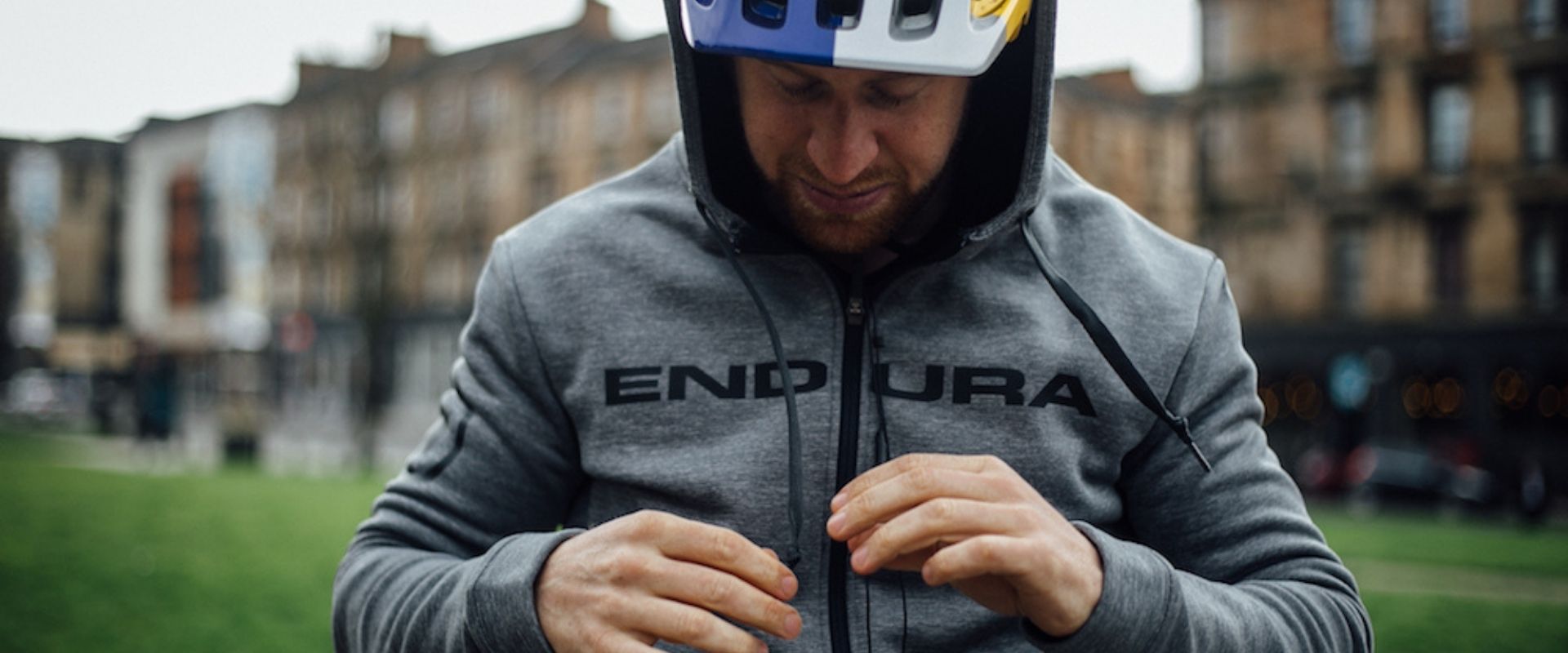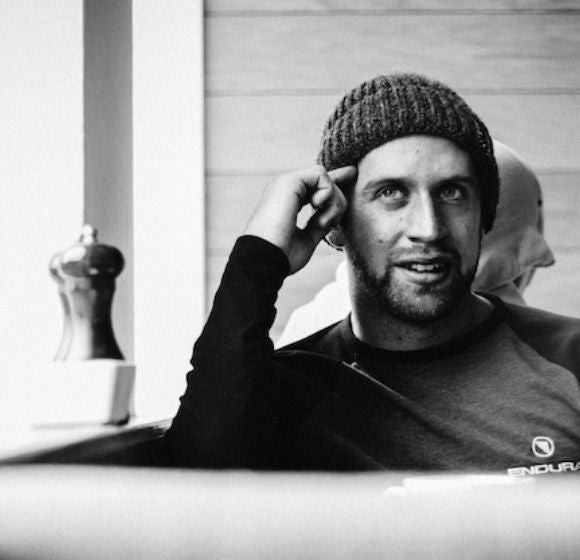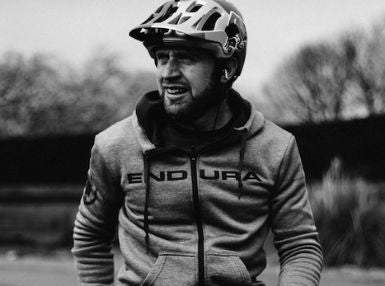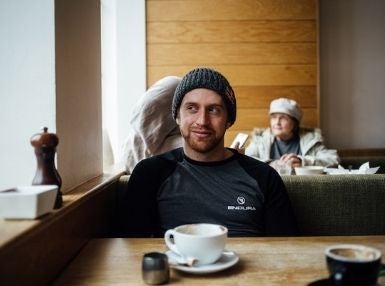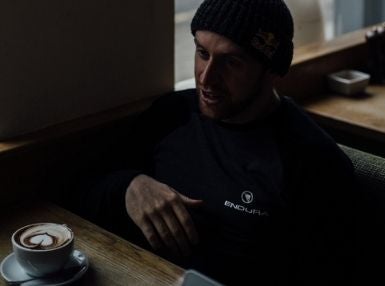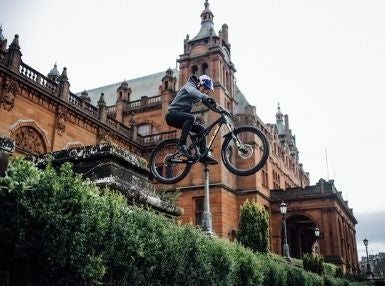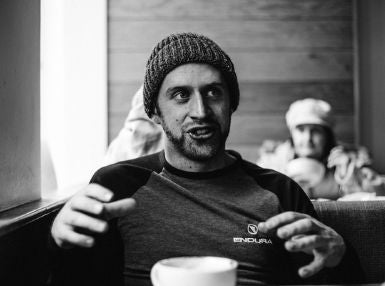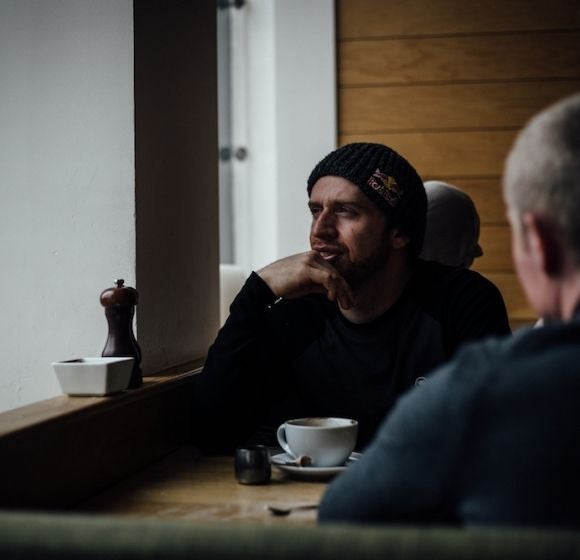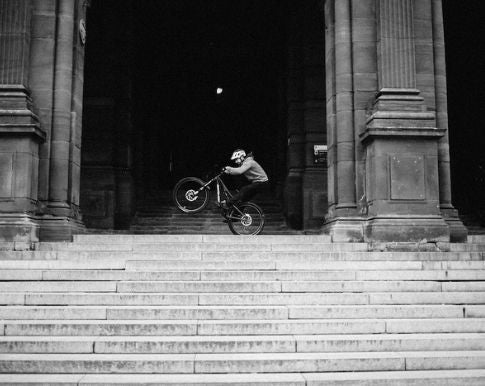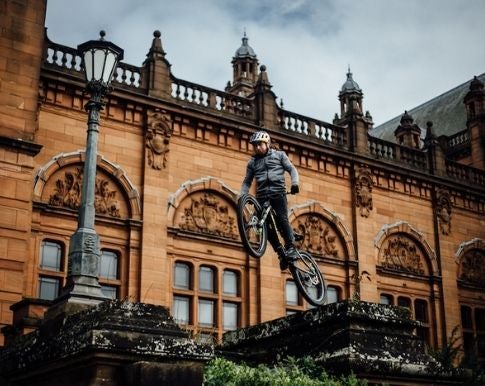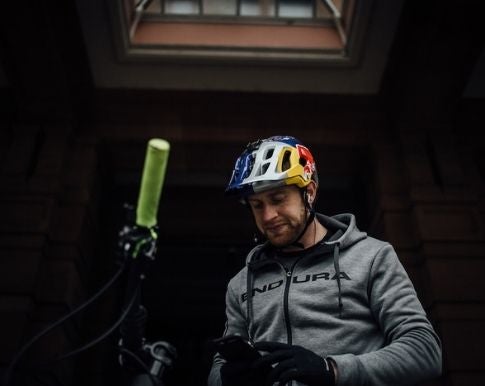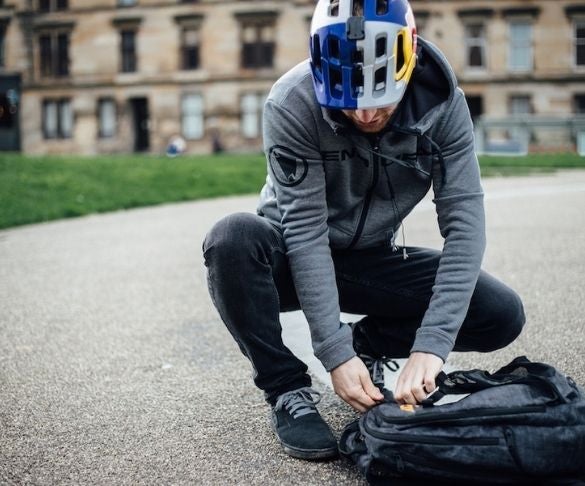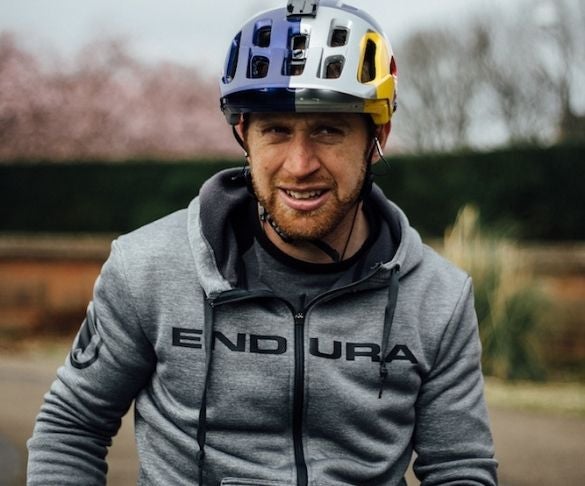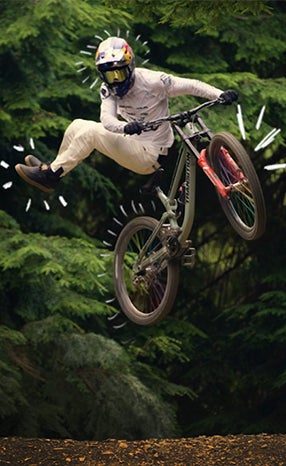THE REAL DANNY MACASKILL
Danny MacAskill is refreshingly down-to-earth, whether chatting in a café, or on his visits to Endura’s vast facility near Edinburgh.
He’s always a welcome guest in Livingston, even if he insists that the pleasure is his.
“The fact that I can go and hang out in the headquarters is really cool for me as well, you know," he says. “I like to operate as friends. That’s the way I think it should be.”
Agreed.
Perhaps we should form a mutual admiration society. Speak to anyone at Endura about our man from Skye, and you’ll encounter an unmistakable sense of pride. Turns out, Danny feels the same.
“It’s kind of something that I wish we’d spoken about earlier,” he says of a relationship rooted in a shared appreciation for proper riding and proper kit. “It's pretty cool that I get to ride for Endura."
Danny’s first experience with the mavericks from Livingston came when he worked in Bothy Bikes in Aviemore. He first wore our clothing in the early 2000s.
“If you had a clothing collection in your shop in Scotland, it was Endura, because they’re from the area,” he explains. “They know how to make tough, hardwearing, good-looking stuff that works in Scotland.”
Agreed. Again.
We’re getting off track. The idea to hook up with Danny on his turf (Glasgow, currently) was to learn more about him. The tricks are breathtaking, the films compelling, the viewing figures astronomical, but beyond a close circle of friends and family, who really knows what makes Danny tick?
GLASGOW CALLING
We meet in The Little Café, a stone’s throw from the Kelvin Hall. The latter is another magnificent edifice, built in Glasgow’s signature red sandstone. It housed the set of Imaginate during 2013, in the period immediately after it ceased to be the city’s transport museum.
“This was our ‘go to’ lunch spot, or where we’d come to treat ourselves,” Danny confides. “If I got a trick done before lunch, then we’d come here for some cheesecake. Half the time, it was more like condolence. I’d be crying into my cheesecake!”
He relates the story with a grin. The back injury and the daily pre-shoot rehab sessions that made filming Imaginate so demanding belong in the past. The impression created in the café remains, however.
Arriving early, photographer Sean Hardy had sought permission to shoot our then-absent guest. When the man himself arrives, it is to smiles from the staff, and looks that say: “You should have told us it was Danny you were expecting.”
His Santa Cruz mountain bike is left outside, upturned and unlocked. If such an expensive machine seems vulnerable stood on its saddle and handlebars, in sight of our table, but only just, then its owner is relaxed.
“I go into shops and leave my trials bike outside all the time,” he says. “My mountain bike is a bit faster, so it would be harder to catch.”
Danny reveals that his trials bike has its own deterrents: a gear so small that any erstwhile bike snatcher would be easily caught on foot, and brakes so sharp that the thief would be thrown over the handlebars at the first attempt to stop.
All of this is delivered in a tone that suggests bike theft is low on Danny’s list of anxieties; assuming of course that he suffers from anxiety of any kind. This is a man, lest we forget, who shunned the security of a safety rope to clamber to the summit of Skye’s Inaccessible Pinnacle with a bike on his back, while filming The Ridge.
“I like to think of the better side of people,” he says with a grin, burying our fears of returning to Endura HQ to report that his prized machine had been stolen during our conversation.
If Danny has become something of a man of the people, in spite of the millions of online views that his films have gathered, then it is because of a down-to-earth demeanour, rooted in the simplest of philosophies.
“I enjoy riding my bike. I enjoy listening to music. I enjoy hanging out with my friends and making these films,” he explains, diffident for the only time in our conversation when I tell him he has made a simple task of the hardest job in the world: bringing happiness to internet users, the world’s angriest community. “I don’t know what to say to that one.”
LETTING DAYLIGHT IN UPON MAGIC
Do not think, however, that such a simple modus operandi stems from a simple character. During our conversation, Danny admits to “assessing everything”, from life outside the café windows, to the spoon on the table.
More than once, he insists that he is not special, even arguing that most people make the same assessment of risk when driving that he does when riding on a cliff edge. It soon becomes apparent however that Danny operates on a different plane to the average punter, off the bike, as well as on it.
“Even when I talk here, I’m just kind of just constantly assessing everything around me, even from small scale…”
The grin returns and he gestures at the cutlery that accompanied the coffee cups.
“I can’t even describe it. I mean, I’ve already assessed like, say, flipping out of a spoon,” he says, laughing. “Not even in a cheesy way, but I'm just kind of looking at everything as edges. It’s a really funny thing. It’s so natural. I’ve done it all my life, pretty much.
He nods in the direction of the window, to the wider world beyond the confines of the café.
“Often, in interviews, when I think about what I’ve been up to, in my head, I’ve been out there riding.”
There is more than one occasion in our conversation where I sense that I’ve lost him. Listening back to the recording confirms as much, and many of the accompanying images show Danny’s gaze directed through the glass. My bad, as the young folk say.
Engage him, and Danny responds with thoughtful, intelligent responses. Ask him questions he has been asked before, or those in which he simply fails to see the logic (bringing pleasure to the internet’s angry millions, for example) and his gaze returns to life outside the window.
Not that he is obtuse, evasive, or anything less than honest. There’s a parallel perhaps with the outtakes that end some of the films. By revealing the truth of his art - that tricks go wrong more often than they go right - he is to some degree letting daylight in upon magic. It says much for his reputation that the ‘making of’ clips are as revered as the films. Not many performers are brave enough to show their rehearsals.
Even Danny struggles to describe exactly why some of his films end with footage of multiple attempts to land a trick. For a conceptual film like Imaginate, he says, it was necessary to show the set to give an idea of scale. For Wee Day Out, it was to demonstrate that things which look easy are often the result of hard work.
There’s an inspirational element too. For a teenaged, would-be trials rider, watching a Danny MacAskill film might seem like aiming at an impossible standard. Danny is keen that this is not so.
“I think it’s in some ways important,” he says of the outtakes. “It kind of shows that it’s real. Nowadays, people see so much fake stuff, it’s become important to show people that it doesn’t happen first time. On the other hand, I could just leave it, and then it puts me up on this different platform, like: ‘How does that happen?’ But I don’t mind.
“If you’re starting at 14, and you’re looking at stuff now, you can progress, but I don’t want to leave it on a level where it’s almost too hard to imagine getting there. So it’s kind of quite good showing that it’s a process.”
A LITTLE HELP FROM MY FRIENDS
The Drop and Roll Tour shows are less demanding than the films, Danny says. He muses on making shorter videos: six months work for a seven-minute edit is labour intensive, especially when you work to his standards, and those of his friends.
The friends are significant. Directors Stu Thomson and Dave Sowerby are mates firstly; artistic collaborators, second. That one member of a social group should become a world class talent is, almost by definition, unusual. That several should do so is a still rarer phenomenon, and yet former downhill racer Thomson (Cut Media) and one-time pro BMX rider Sowerby are directors held in high esteem.
What are the mechanics of the relationship? Danny admits to being “a bit backseat driver-ish these days”. So is he conductor of the small orchestra to which a film crew might be compared, or first violin? It’s hard to imagine him as the sort of leading man who retires to his trailer after the perfect take.
Unsurprisingly, he says that his first priority is to capture the riding (“If you can’t see the height of the building I’m jumping from, then there’s no point in me doing it”), but he has come along way since his days in Aviemore, when his response to friend Nash Masson’s suggestion that he should film his riding was, “It might be a bit of a laugh”. Today, he is likely to be as close to the editing process as the riding.
“I suppose it is to realise my vision,” he says with a half-smile, and in a tone suggesting a different phrase to the one I volunteered might have suited him better (“It sounds a bit full on”).
“I mean, I get very obsessed with these projects, like this morning, when I’m drawing my ideas. If I kind of open up to it, I can easily write down 40 new tricks that probably haven’t been done before, or I’ve never tried. It’s quite easy to write them down; it’s another thing to put them onto film. You could draw a double backflip, a huge drop, and you know it would be physically possible, but then you’ve got to learn it and do it.”
Even drawing some of Danny’s tricks can’t be easy, despite his claims to the contrary. The Opposite 360 from Imaginate almost defies the law of physics.
MUSE-ICAL PREFERENCE
Increasingly, Danny’s creative urge finds an outlet in music. He describes Spotify as “the most life-enhancing technology I own”, barring the bike, of course. The bike, he explains, “is just part of me”.
He played the piano a little as a child, and believes that editing software offers an opportunity for non-instrumentalists to lay down the bare bones of a track. To chat with Danny about music is to speak to one fully engaged. He describes music as motivation to ride, even when he is alone, in the dark and rain. It is a force, he says, that drives his ideas.
“It doesn’t even have to be motivating music, as such; it doesn’t have to be music that’s fast or energetic. It can just be music that sparks an idea that I’ll get excited about, like with Epecuén or Cascadia. You listen to the music and you can just see how it would all cut [together]. And that’s what really drives me at the moment, so I would even like to get in to trying to create the music side of it, although I don't want to get above my station.”
When I ask what he’s listening to currently, he replies in a single word.
“Everything.”
He spends a few hours each day on Spotify: when riding, of course, but also before bed. He admits to “surfing” the app in the way internet users would surf the web in its early days, before search engines and optimised websites removed the need. Danny relishes his rambles through Spotify’s musical landscape. The “related artists” recommendations send him on enjoyable tangents.
“There are so many different ways to use it,” he says. “I find it a very, very useful tool, and it definitely inspires me a lot.”
ENVIRONMENTAL HEALTH
Environment is another motivating factor. He has found new inspiration wherever he has lived, from Dunvegan on Skye, to Edinburgh, and now Glasgow. He admits that the appeal of Scotland’s largest city is starting to wane, and has considered for two years moving to other locations, from central Europe to the West Coast of America.
Epecuén might serve as Exhibit A in Danny’s desire to seek out somewhere new to showcase with his riding talents. The ruined village in Argentina, a former tourist resort, flooded in 1985, has been abandoned by all but its last remaining resident, Pablo Novak. An elderly man, Novak appears in the film’s opening sequence.
Epecuén can hardly have been on any rider’s radar but Danny’s. The obstacles he tackles are precarious at best - a telegraph pole slumped at an angle of about 45 degrees to the ground is among the mildest - and yet the location, for all its decay, prompted the rush of creativity that accompanies his relentless assessment of new riding opportunities.
“Whenever you go to a new location, you immediately switch on,” he explains. “Especially when you’re filming, you’re doing that all the time, but you take note of the biggest opportunities, and I try to write those down in a list.
“Scouting is very important for me…If we’re doing the more conceptual films, it’s very important to spend some time - days even - looking around to find the best opportunities for what you’re going to put your energy into.
“You just make a list and usually put the four biggest tricks at the end, so danger-wise you can kind of make it there, and if you get down to number 16 out of 20, then you’ve got ‘a film’. If you manage to get to 20 - and often you do, eventually - you have something like what you’d imagined.”
SKYE PATROL
You can take the boy out of Skye, but it might be impossible to take Skye out of the boy. Danny is a product of his upbringing: a wonderfully riotous boyhood, conducted within the caring confines of responsible parenting. Descriptions of Danny’s formative years in Dunvegan would seem far-fetched, were they not true.
The man himself describes his early home life as “a free for all,” with bonfires burning in the back garden, fishing nets hung as makeshift safety nets for his earliest experiments with acrobatics (flinging himself from trees), and, of course, an area for bicycle trials, “churning the place to mud over winter.”
Danny now sees the bravery in his mother Anne’s resolution to adapt, rather than to wrap her son in cotton wool. And he admits to an occasional lack of confidence in others, that causes him anxiety. If Danny is engaged in something like riding on a cliff edge, and has noticed a member of the party tripping on the pathway on the walk to the shoot, he can feel anxious.
“I sometimes don’t have the faith in others that I should,” he says, laughing. “If I ever have kids, it will be interesting. I’ll force myself to turn a blind eye.”
The greatest gift a parent can give a child is freedom, but this is no small undertaking. Danny’s childhood might have been all that a boy could wish for, but it was not feral. He was free to explore, but not to run wild. Anne MacAskill’s cameo in Imaginate, where she threatens to “shoot the boots” from her young son, if he doesn’t report immediately to the dinner table, has the ring of truth.
Peter MacAskill is another key influence on Danny’s life. Somewhat ruefully, the son admits to similarities with his father, the proprietor of Dunvegan’s Giant MacAskill Museum, an institution inspired by an outsized ancestor with a penchant for entertaining.
Now 31, Danny admits that he wouldn’t be the rider he has become, were it not for his upbringing. He even jokes that, “It might have blurred some lines about what I think is acceptable!”.
“I look at things in the same way as I used to back then. I’d constantly look at the trees: ‘How could I change this?’ I had the freedom to go and do whatever I wanted to do, and it’s the same kind of thing now. I get to kind of still be that eight-year-old.”
SOLO ARTIST, GLOBAL CITIZEN
Danny has left Skye and Dunvegan, of course, striking out first for a job at Bothy Bikes in Aviemore, and then for Macdonald Cycles in Edinburgh. Now that work commitments no longer dictate his living arrangements, he has moved to Glasgow, to a flat he shares with friends. He still often rides alone, even if he has a solid group of friends. He rode solo from necessity in the early days, and has maintained the habit, partly out of admiration for “the top guys.”
“They’re motivated to push themselves by themselves; for themselves, or whatever,” he explains.
“You’ve got a lot of your own time, and that’s the time when you don’t have to gather together a group of friends to go and do something. Instead, you can go out there and do it yourself. I had to learn to do that, living on Skye, because my friends lived out of the village. I just wouldn’t have ridden otherwise. There was nothing else to do except to go out on the bike.”
If there’s an obvious theme of Scottishness, then it is by happy accident, rather than design. That so many of the films are made in his homeland is often a matter of finance and logistics. Why spend a third of the production budget on travel, with backdrops like those in Scotland to be had for free? But Danny is a global citizen, and not one to wrap himself in Saint Andrew’s Cross.
“I’m not there flying the Saltire,” he says. “Skye is definitely home, definitely where my heart is, but I am open to the world.”
DIGITAL LANDSCAPES
Physical location is one thing, but the media landscape, essential to a filmmaker, has changed dramatically in the last 10 years. Danny’s early experiments with film came at a time when a mountain bike rider of almost any discipline would wait for their monthly subscription to Dirt or MBUK to drop through the letter box, and the trials rider would head directly to the latter’s two-page ‘Hip Hop’ section.
Compare and contrast with the Instagram generation. It’s an interesting twist of fate that a rider who grew up in a house with a television that received just four channels (“and I didn’t particularly watch much TV”), and who waited anxiously for magazine subscriptions to arrive, is now one of the biggest stars in the digital firmament.
The viewing figures are, to be blunt, astonishing. As of writing, Imaginate has nearly 65.5m views. The Ridge has been watched 45.5m times. Cascadia and Epecuén are comparatively niche, with “just” 21.5m and 12.7m views respectively. None of this, however, appears to mean much to Danny, a rider with an artist’s soul.
“I’m not driven to get the viewing figures, or anything like that. It’s just that I really enjoy coming up with ideas and we make them to the best of our ability. We go all in, and then people can think what they want.”
FIRST-NAME TERMS
We return to where we began.
Our drinks finished, Danny suggests heading across the road to the museum, to capture some riding shots. He rides along a low rail as I walk alongside, and with such ease that I barely notice. While we discuss photo options, he sits the bike with both feet on the pedals, perfectly balanced.
The riding is, as we have described, breathtaking, but there’s time for one more quintessential “Danny moment” before we leave.
As he rides up the gallery’s imposing steps, and manuals between the giant sandstone pillars that mark its entrance, a female security guard emerges from inside and begins talking into a radio.
I hurry over to explain that there is no danger, that the rider is in complete control, and that we’ll be going soon, anyway.
“Oh, it’s fine,” she says, totally calm. “I know who he is. It’s Danny.”
FOOTNOTES Words by Timothy John. Images by Sean Hardy
© 2021 ENDURA
